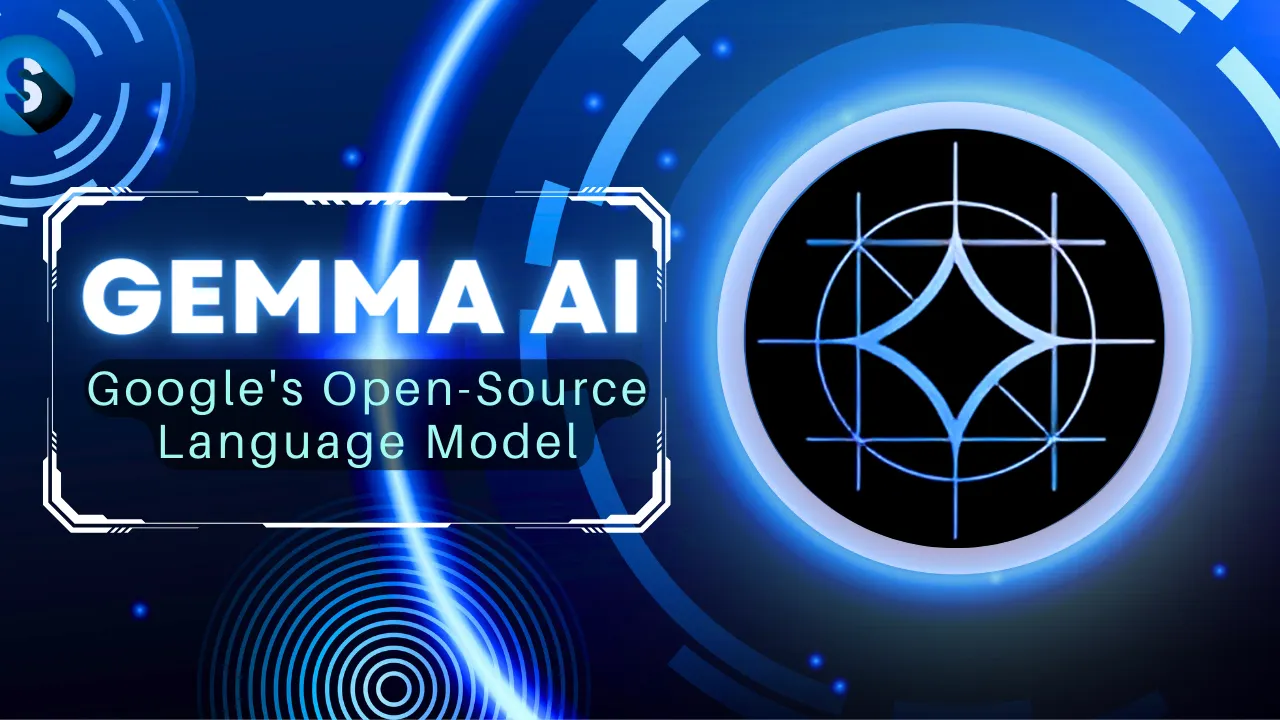Get straight to the future of AI with Gemma, Google’s open-source language model. This powerful tool is poised to shake up the NLP world, offering a lightweight, customizable solution for developers and researcher
But what exactly is Gemma AI? Let’s dive in and explore its potential.
What is Gemma AI?

- Gemma AI is a family of state-of-the-art language models developed by Google AI.
- It utilizes cutting-edge transformer technology to process and generate text.
- Gemma’s core advantage: it’s open-source, making it freely available for use, modification, and distribution.
- Explore Gemma AI Models on HuggingFace
Gemma offers flexibility for developers. For those interested in quick chatbot creation, tools like Poe AI provide no-code solutions.
Key Advantages of Gemma AI
Lightweight and Efficient:
This is particularly evident with Gemma 2B. Due to its smaller size, it demands less computational power and memory compared to many other large language models. This makes it suitable for deployment on devices with limited resources.
Open-Source Advantage:

Being open-source allows:
- Customization: Developers can fine-tune Gemma for specific tasks and domains, tailoring it precisely to their needs.
- Community Innovation: A wider pool of researchers and developers can experiment, improve, and analyze the model, accelerating progress in the field.
- Transparency: Open access enables greater scrutiny of the model’s inner workings, potentially leading to a better understanding of its behavior.
Instruction Following:
Gemma models, particularly the instruction-tuned versions, excel at following instructions and completing tasks as directed. This makes them valuable for building conversational AI systems and task-oriented applications.
Focus on Responsible AI:
The Gemma development team emphasizes several aspects of responsible AI:
- Data Filtering: Efforts are made to reduce harmful content in the training data.
- Safety Benchmarks: The models are evaluated on standard safety benchmarks to measure biases and harmful outputs.
- Responsible Toolkit: Google provides a toolkit to help developers integrate responsible AI practices when building applications.
Gemma 2B vs Gemma 7B
The Gemma family of language models is based on the transformer decoder architecture, with some key improvements for performance and scaling. Now let’s explore the primary differences between the 2B and 7B versions
Architecture and Size
- Gemma 2B:
- 18 layers
- 2 billion parameters
- Smaller footprint, ideal for more constrained hardware
- Gemma 7B:
- 28 layers
- 7 billion parameters
- Significantly larger, demanding greater computational resources
Performance
- General Language Tasks: Gemma 7B consistently outperforms Gemma 2B due to its larger size and capacity. This is evident in benchmarks for question-answering, reasoning, and code generation.
- Mathematics and Coding: Gemma 7B demonstrates markedly superior performance in math-related tasks and code generation compared to the 2B model.
- Memorization: Both models have relatively low memorization rates of training data. However, Gemma 7B’s greater capacity may lead to slightly higher memorization.
Use Cases
- Gemma 2B:
- Resource-constrained Environments: Use when hardware limitations are a concern.
- Rapid Prototyping: Ideal for faster experimentation and building proof-of-concepts.
- Baseline Performance: Provides a solid foundation for tasks but may not be suitable for the most demanding applications.
- Gemma 7B:
- High-Performance Applications: Best when maximum performance on complex language tasks is crucial.
- Challenging Math and Coding Problems: Excels in complex reasoning and code generation.
- Cutting-Edge Research: Suitable for pushing the boundaries of language model capabilities.
Important Considerations
- Computational Cost: Gemma 7B’s larger size requires significantly more computational power and memory resources compared to the 2B model.
- Task Complexity: For simpler tasks, Gemma 2B might be sufficient, while demanding use cases necessitate the power of Gemma 7B.
The choice between Gemma 2B and Gemma 7B depends largely on the task requirements and available resources. Gemma 2B offers a balance of performance and efficiency, while Gemma 7B stands out for its raw power and performance ceiling.
How to Use Gemma
There are several ways to access and experiment with Gemma:
- Kaggle: Explore Gemma’s capabilities directly within Kaggle notebooks, a popular platform for data science and machine learning. Start using Gemma API with Kaggle here
- Google Colab: Tap into the power of Gemma on Google Colab, which provides free access to cloud-based computing resources. Get started with Gemma
- Google Cloud: For larger-scale or production-level projects, consider deploying Gemma within the Google Cloud infrastructure. Learn how to deploy Gemma in Google Cloud using Vertex AI
Google sometimes offers grants or credits for those doing innovative research with Gemma. apply for Google Cloud credits
Use Cases

Gemma AI opens up a wealth of possibilities for developers and businesses.
- Text Generation:
- Craft creative writing pieces like poems or short stories.
- Generate different types of code.
- Draft emails, scripts, and other text formats.
- Multi-modal Potential: While the current Gemma models are text-focused, their architecture and underlying technology hold promise for future multi-modal capabilities (handling image, audio, and other modalities alongside text).
- Translation: Seamlessly translate text between languages.
- Summarization: Extract concise summaries from lengthy articles or documents.
- Question-Answering: Build systems that provide answers based on a body of text or knowledge.
Potential use case:

Multi-modal Potential: While the current Gemma models are text-focused, their architecture and underlying technology hold promise for future multi-modal capabilities (handling image, audio, and other modalities alongside text).
While Gemma shows impressive capabilities, it’s valuable to compare it against established models like Claude 3 and ChatGPT
AI Language Models Comparision
Gemma AI offers a unique mix of features, making it a compelling choice in many scenarios. To make informed decisions, it’s helpful to understand how it compares to other players in the field:
- Gemma AI vs. ChatGPT: Both models excel at generating text but differ significantly:
- Gemma’s open-source nature allows for greater customization.
- Gemma’s smaller size often translates to faster processing and lower resource requirements.
- Objective Comparison: While Gemma AI excels in specific areas, consider the following before choosing a model:
- Project Scope: Larger projects may benefit from models with wider knowledge bases.
- Customization Needs: Gemma offers more flexibility if extensive modification is required.
- Resource Constraints: Gemma is ideal when computational power or memory is limited.
| Feature | Gemma (2B) | Gemma (7B) | ChatGPT | Jurassic Jumbo | Claude |
| Developer | Google AI | Google AI | OpenAI | AI21 Labs | Anthropic |
| Size (Parameters) | 2.2B | 7B | 175B-100T | 178B | + 500B |
| Open-Source | Yes | Yes | No | No | No |
| Computational Cost | Low | Medium | Low-Medium | High | High |
| Speed | Fast | Moderate | Moderate | Slow | Slow |
Lightweight language model: Intentional and Advantageous

- Accessibility:
- Runs on regular devices (laptops, mobile) due to smaller size.
- More accessible for developers and researchers without large computing resources.
- Efficiency:
- Faster execution times.
- Lower energy consumption, ideal for resource-constrained applications.
- Open Source Focus:
- Easier for researchers to understand, modify, and build upon.
- Encourages collaboration and innovation.
Trade-offs:
- Performance: This may not match the most sophisticated tasks handled by giant models.
Gemma’s Strengths:
- Prioritizes accessibility, efficiency, and open-source principles.
- Excels when these factors are more important than raw performance power.
Check out our Gemini vs ChatGPT analysis
Conclusion
Gemma AI marks a significant step forward in open-source language models. Its unique combination of efficiency, customization possibilities, and focus on responsible AI positions it to greatly impact various fields.
- Accessibility: Gemma lowers the barrier to entry for AI development and research.
- Innovation: Its open-source nature fuels community-driven advancements.
- Ethical Considerations: Gemma encourages thoughtful and safe development of AI applications.
If you’re a developer, researcher, or simply curious about the future of AI, Gemma AI is worth exploring. Try it out on one of the available platforms and see how this adaptable tool can empower your projects.


Thank you for your openness to explore various topics!